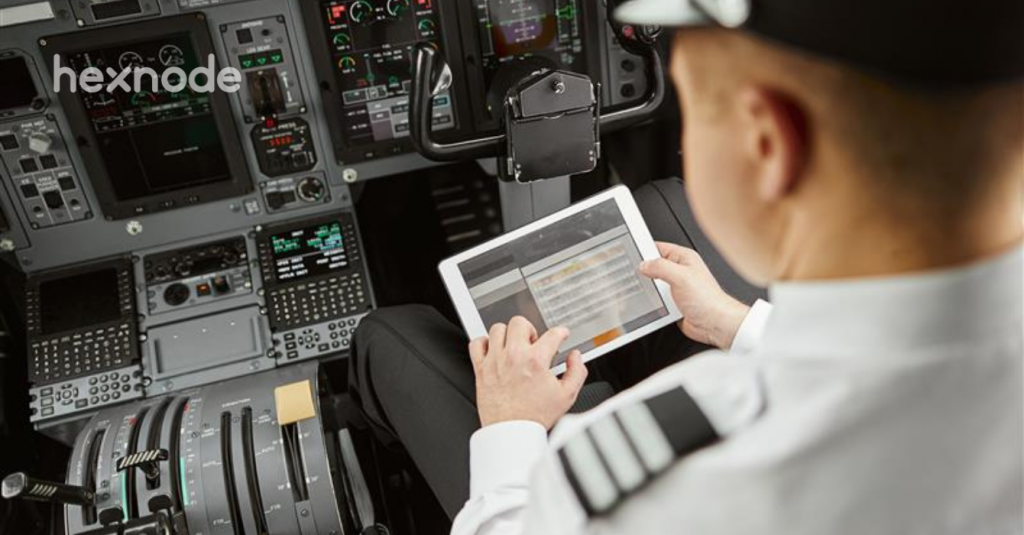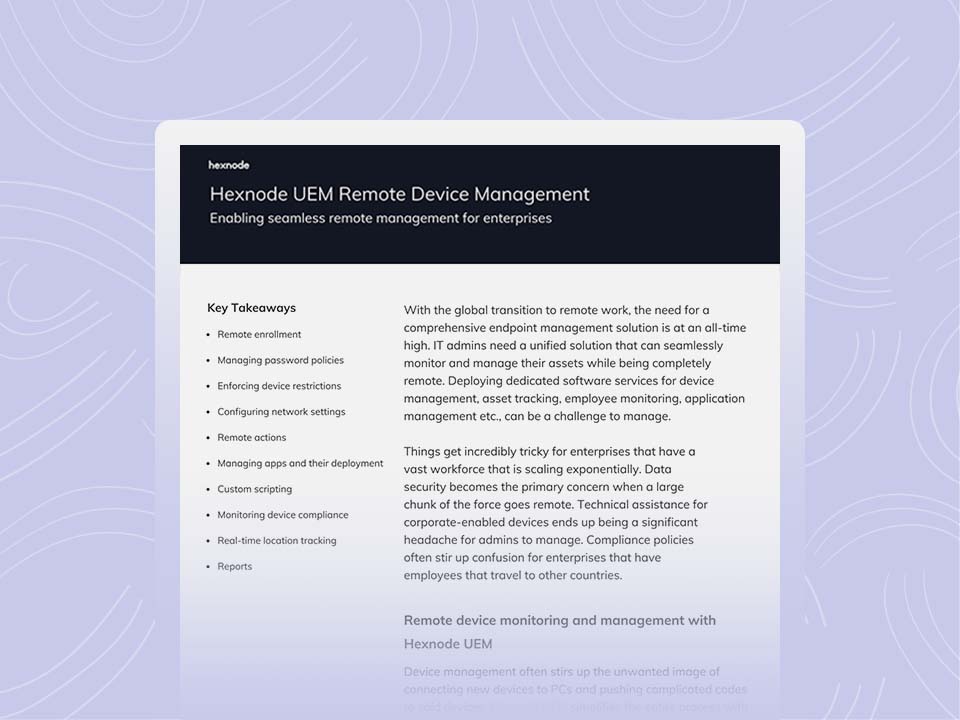MDM remote access: The essential tool for real-time troubleshooting
Resolve device issues instantly with MDM remote access—troubleshoot, update, and secure endpoints in real time, anytime, anywhere.

Get fresh insights, pro tips, and thought starters–only the best of posts for you.

The aviation industry thrives in an environment where precision, security, and efficiency are non-negotiable. With millions of passengers expecting safe and timely flights each day, the stakes are incredibly high. Every aspect of flight operations, from check-in systems to in-flight communication, relies on a complex web of interconnected devices. Managing this complex network of devices, while ensuring security and keeping systems updated in real-time is no small feat. Especially in an industry that is both highly regulated and frequently targeted by cyber threats. That’s why aviation industry increasingly turning to unified endpoint management (UEM) systems to improve efficiency and security.
In an airport, every department is equipped with its own specialized devices- pilots have tablets for flight information, ground staff use mobile devices for coordination, and cabin crew handle devices for passenger service management and in-flight entertainment systems. Managing such a broad spectrum of devices across multiple operating systems and operations creates a fragmented network that is challenging to manage and coordinate.
From customer information to critical flight operations, the aviation industry is entrusted with vast amounts of sensitive data which makes it vulnerable to cyber threats. A single security breach could lead to serious consequences, including flight delays, operational disruptions, or unauthorized exposure of confidential data.
Aviation relies on precise coordination of schedules and workflows, making any operational hiccup especially disruptive. Even minor delays can quickly cascade through multiple flight schedules and operational workflows. Devices that encounter technical issues or run outdated software can lead to significant operational setbacks which can negatively impact productivity and service levels.
Given the strict regulations set by Federal Aviation Administration (FAA) and European Union Aviation Safety Agency (EASA), aviation companies must consistently meet safety, data protection, and operational standards. Failing to comply carries serious risks: significant legal liabilities, the loss of crucial certifications, or even exclusion from key markets. Beyond these immediate risks, non-compliance can also hurt a company’s reputation, leading to weakened business partnerships and a loss of customer trust in a highly competitive industry.
Aviation devices are not confined to a single location—they’re scattered across airports, aircrafts, and remote airport terminals, making device management complex. Without efficient remote oversight, it’s harder to keep software updated, resolve technical issues in real-time, and ensure data security. This can lead to operational delays, service disruptions, and security breaches, directly affecting service quality and regulatory compliance.
As mentioned earlier, UEM handles the wide range of devices used in aviation industry, regardless of the platform or system they operate on. By bringing them all under a single dashboard, it simplifies the management of everything from the ground crew’s tablets to the pilots’ systems. Let’s take a closer look at how it all comes together.
Managing a diverse fleet of devices in an airline is no easy task, but there’s no better tool for the job than unified endpoint management (UEM). It simplifies device management by managing and securing devices powered by all the different operating systems from a single interface.
With UEM, aviation companies can oversee all their devices through one dashboard, simplifying tasks such as updating, monitoring, and configuring role-specific settings. This approach not only reduces complexity but also ensures that the devices remain secure, compliant, and operational across teams and locations.
Everything runs smoothly, and every device stays in check—just like clockwork.
Monitoring and optimizing scattered devices across an airport can be challenging, but UEM plays a crucial role in simplifying this process. It enables IT teams to monitor device health, push critical updates, and troubleshoot issues in real time. This minimizes downtime and reduces the risk of delays, ensuring that the operational infrastructure remains robust. As a result, UEM helps prevent disruptions, leading to smoother operations and fewer costly inefficiencies.
Get started with Hexnode’s Unified Endpoint Management solution and know more about Hexnode’s core endpoint management features.

Featured resource
Hexnode UEM Remote Device Management Datasheet
As mentioned previously, security and regulatory compliance are non-negotiable in aviation. And so, UEM plays a crucial role in enhancing endpoint security in aviation industry through features like encryption, remote wipe, and access control. When a device is misplaced or stolen, many UEM platforms equip the IT teams to lock the device, track its location, or if necessary, remotely erase sensitive data. These functionalities help ensure compliance with industry regulations, such as those set by FAA and EASA, so you can stay confident that you’re protected against compliance breaches.
For airlines, ensuring all mission-critical devices are equipped with the correct apps and update-versions is crucial. However, managing app deployments and updates across a vast fleet can be quite overwhelming. UEM simplifies this process by allowing remote installation, updates, and the ability to control app versions, configurations and restrictions. This ensures all employees have the right tools, reducing inefficiencies and maintaining smooth workflows.
In aviation, each role requires specific tools and applications to perform effectively. With UEM, companies can automate the process of assigning device configurations based on job roles.
This ensures that each employee has access to the tools they need without manual intervention—pilots receive flight-related applications, ground crew get service tools, and administrative staff are provided with the appropriate software. By delivering tailored access to each role, UEM boosts efficiency and minimizes the risk of unauthorized access, keeping operations secure and organized.
From self-check-in kiosks to flight information display systems, these devices play a crucial role in ensuring the smooth operation of airports. UEM offers a robust solution for managing these vital components by deploying and managing kiosks that can efficiently lock these devices into specific functions, preventing unauthorized use.
Additionally, UEM empowers IT teams to broadcast urgent messages directly to these devices, ensuring important updates or alerts reach the right people instantly, enhancing operational efficiency and responsiveness across the airport.
Managing the vast network of endpoints in aviation is inherently complex, with thousands of devices scattered across different locations. UEM utilizes automation as a tool to simplify this complexity and make operations more manageable.
With automation, UEM helps ensure that all endpoints adhere to the strict regulations of the aviation industry. By automatically applying security policies, managing configurations and generating compliance reports, it significantly reduces the burden of manual checks. Though some level of manual oversight is still required, automation helps minimize the time and resources needed for routine verifications.
Automation guarantees uniform system configurations, by smoothly deploying updates, patches, and policies to keep devices secure, optimized, and responsive to vulnerabilities.
Automation helps in tracking device usage, health, and location, allowing for efficient asset management and minimizing the risk of device loss or theft and effectively limiting the need for physical audits or check-ins.
With UEM, the deployment of apps, troubleshooting issues, and maintaining devices can all be automated, ensuring smooth operations without manual intervention and further reducing operational disruptions.
UEM solutions have proven invaluable in addressing critical challenges within the aviation industry, such as:
The rush and hubbub of managing the timely arrival and departure of countless flights on a daily basis could sometimes cause some very inconvenient hiccups. One such hiccup is misplacing a company-issued tablet containing sensitive flight information and passenger data. In the wrong hands, this could lead to a significant data breach, jeopardizing both data security and regulatory compliance.
But what if you could mitigate this risk efficiently through a UEM solution?
Here’s how UEM can help:
With UEM, airlines can swiftly address data risks, safeguard information, and ensure compliance—all managed effortlessly.
During compliance audits, missing security configurations on devices can put airlines at risk of regulatory violations, leading to fines, legal issues, and reputational damage.
Here’s how UEM can help:
With UEM, airlines can maintain regulatory compliance, prevent costly penalties, and uphold security standards without disrupting operations.
In-flight service can sometimes hit a snag with unexpected technical issues. For instance, the cabin crew might face a malfunction in the in-flight sales system mid-flight, which disrupts service and risks revenue loss.
UEM as the solution:
With UEM, the airlines minimize downtime, avoid lost revenue, and ensure a seamless customer experience, allowing the crew to resume sales swiftly.
These scenarios highlight how UEM plays a critical role in managing key challenges in aviation, from lost devices and operational inefficiencies to maintaining compliance and security standards.
The aviation industry’s reliance on technology has introduced new challenges, from managing a vast array of devices to ensuring that sensitive data remains secure. Unified endpoint management (UEM) has become an indispensable tool for aviation industry, helping enhance cybersecurity, automate routine processes, and improve operational efficiency while minimizing risks.
Here Hexnode UEM stands out with its robust features for easy device setup and user permission management. It addresses the unique needs of the aviation industry while enhancing security and efficiency for quick resolutions.
Sign up for a 14-day free trial and explore Hexnode UEM's device management capabilities.
SIGN UP NOW!